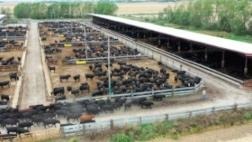Depending on where you are, agriculture today is based mainly on simplified rotations such as the corn/soybean system in the Midwest. Planting cover crops is a great first step, but to reach ambitious goals for GHG emissions reduction and regenerative / soil building acres, farming systems and livestock feed need to include more diverse crops.
Bill Couser was intrigued by diversifying his rotation and planting small grains. He runs a 10,000-head beef cattle farm in central Iowa and grows 5,000 corn and soybean acres, much of which feeds his cattle. He sees planting oats in place of some corn acres as a way to get a legume cover crop in the rotation that will fix nitrogen in the soil, helping him save on input costs the following year, as well as build other soil health benefits. His questions were, would his cattle perform well on an oat ration? Would incorporating oats sacrifice efficiency? What would it cost?

Couser Cattle Company
Crop rotation is one of the most important principles of regenerative agriculture and a key unlock to a low-emission cropping system. Many global food and beverage companies have set GHG emissions reduction goals that span their value chain, including McDonald’s. Beef cattle, including the production of cattle feed, is one of the largest contributors to McDonald’s overall supply chain carbon footprint and presents great opportunity for interventions. The company also has a vested interest in improving the resilience of farming systems in their supply chains and wanted to understand the value of feeding cattle small grains, like oats, as a way to bring emissions reductions and soil building practices onto the landscape. Their questions were, is there a GHG reduction win? What are the costs and benefits of incentivizing small grains in feeding rations to get more resilient farming systems?
Together the Sustainable Food Lab, Practical Farmers of Iowa, McDonald’s, and Couser Cattle Company set out to answer these questions. Couser fed a group of cattle a ration with 22% oats and compared performance to a group of cattle fed a standard corn ration.
The feeding trial successfully answered the initial question about animal performance. The comparison of a ration with 22% oats to a standard corn-based ration resulted in no statistical difference in body weights, cattle performance, or carcass quality.
The trial also answered a second question about cost. The ration with oats cost more to finish cows, since oats were more expensive than corn on a pound-for-pound basis (using 2020 prices), and cows require approximately twice as many oats to achieve the same gain as corn.
The trial’s third topline finding uncovered the GHG emissions impact of incorporating a small grain into the feed ration to finish cattle. On the farm, when a red clover cover crop is planted along with oats, net GHG emissions are reduced even when taking into account the total emissions produced by the beef cattle. The red clover in the small grain system makes it possible for farmers to reduce nitrogen fertilizer in the following year’s corn by 40-100lbs. Planting a red clover cover crop also results in additional carbon sequestration.
Click here to see more...